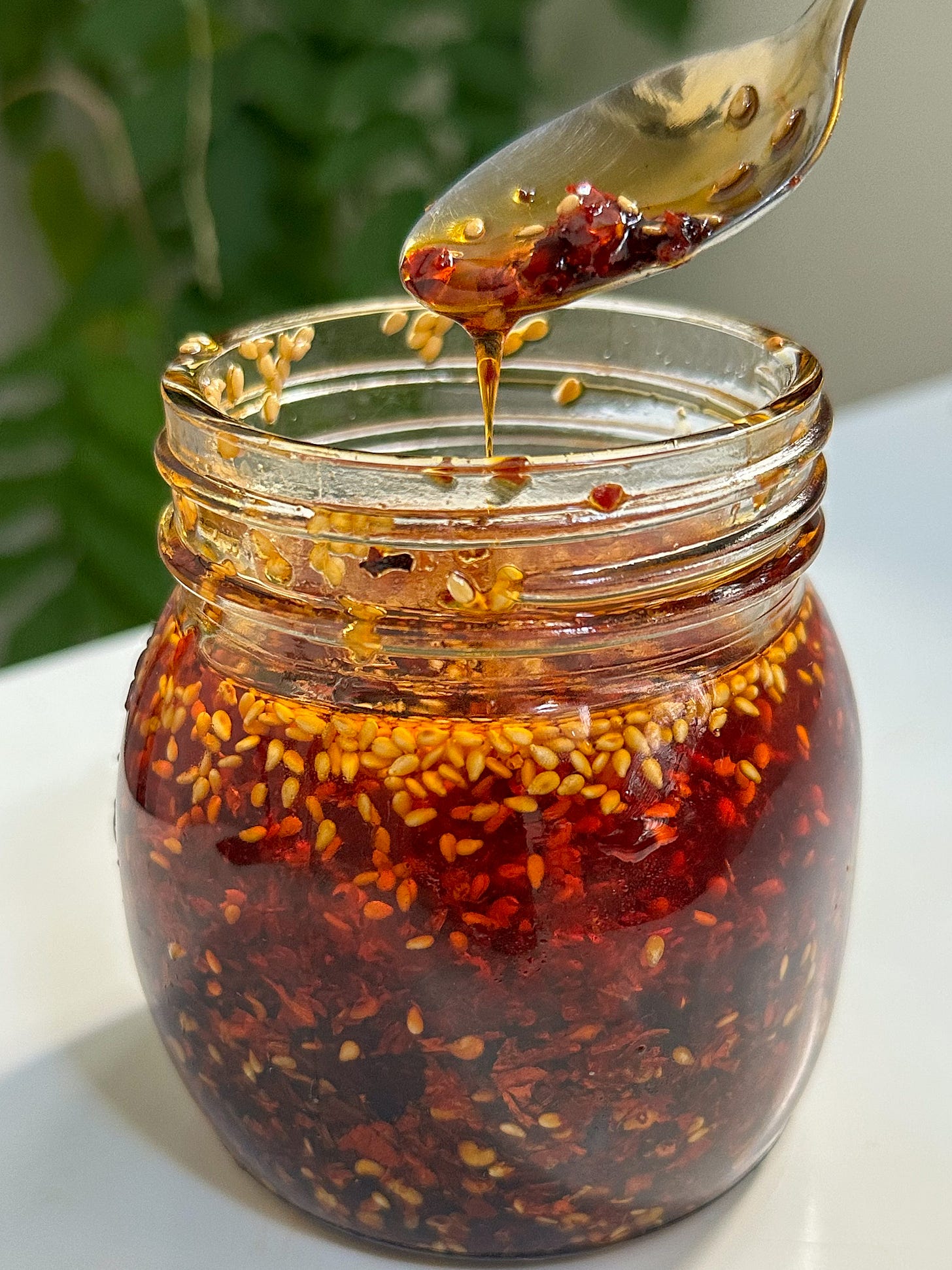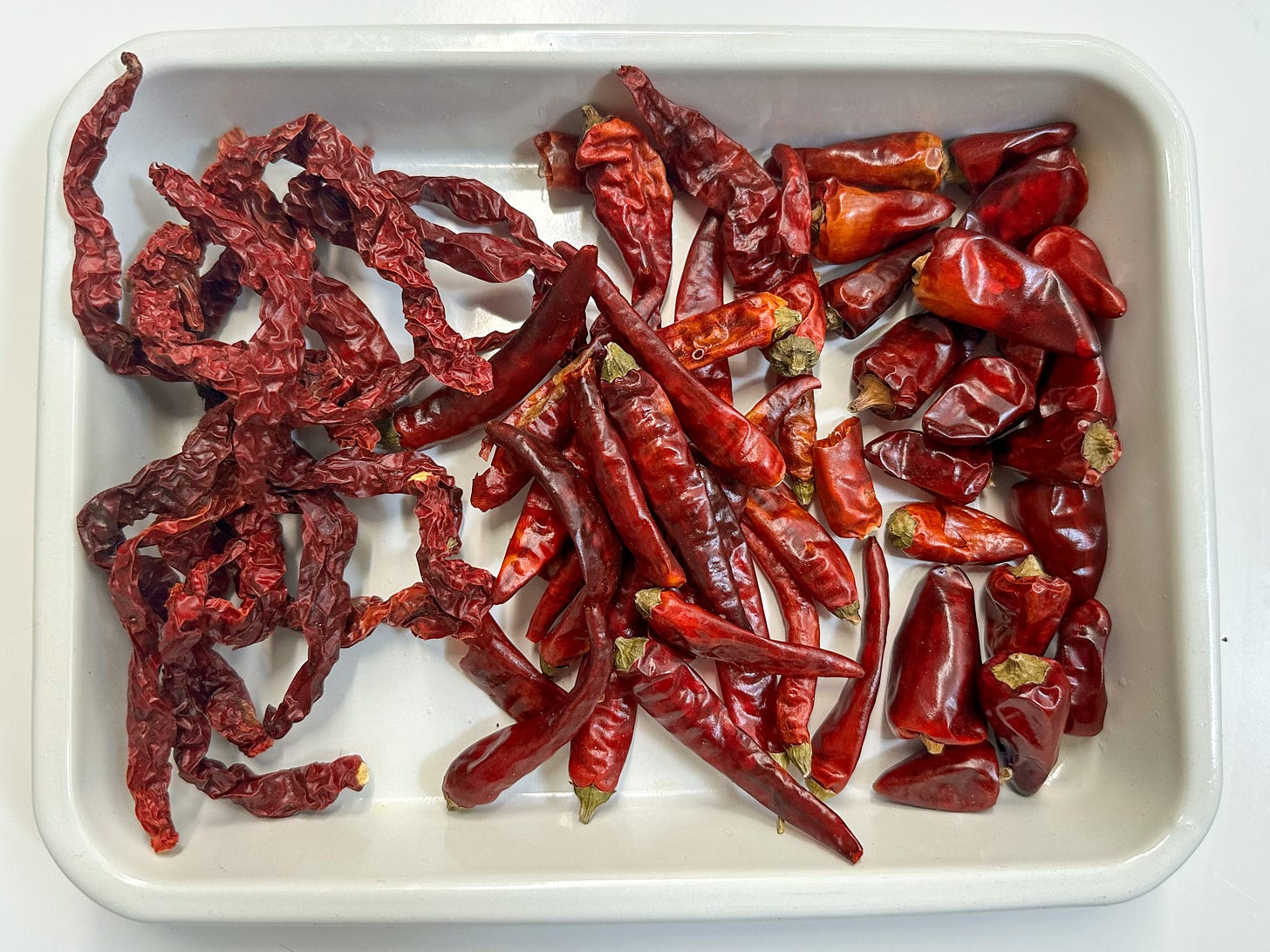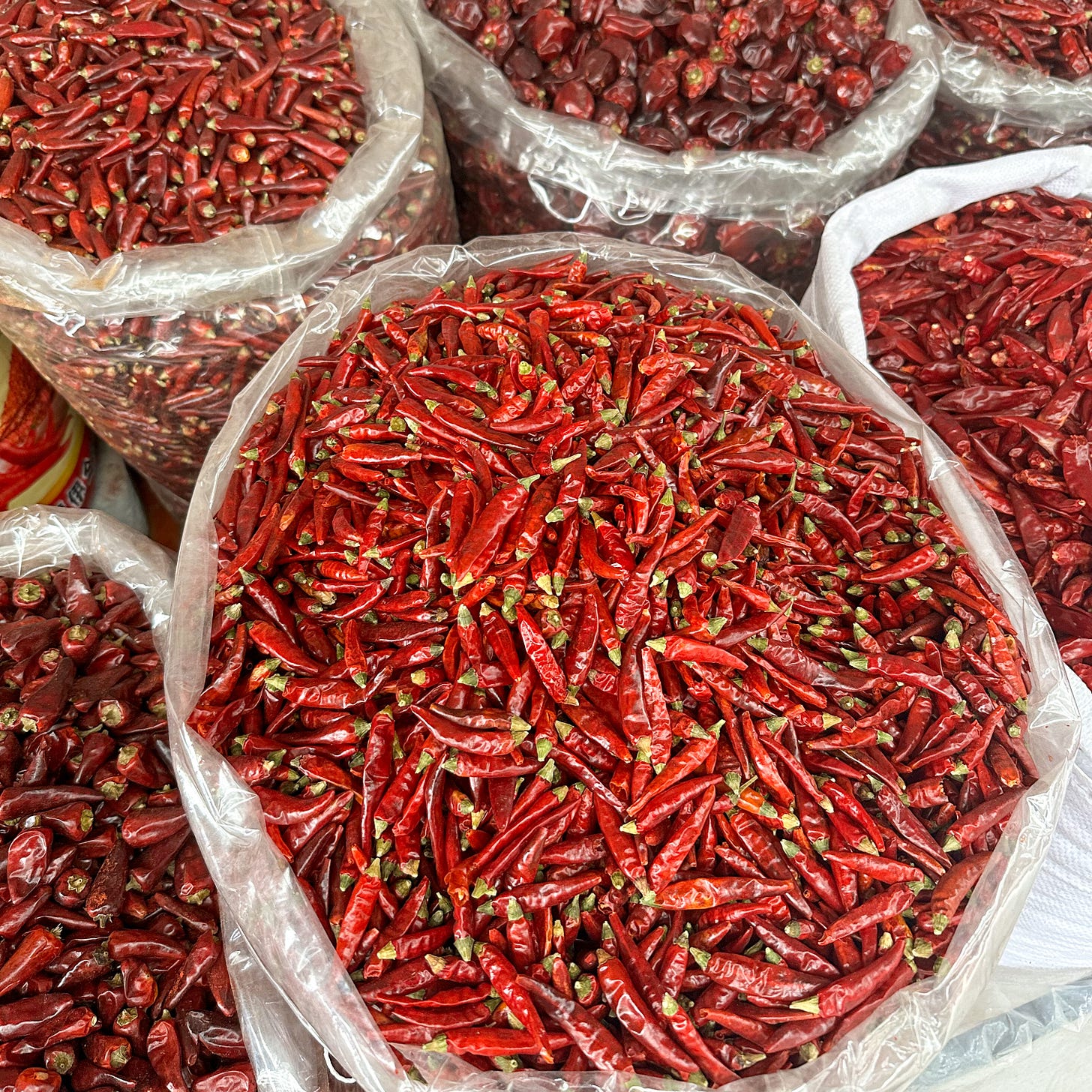Homemade Sichuan Chili Oil
A deep dive into this essential condiment for every Sichuan kitchen
Hi! Today’s recipe is about chili oil. I’ve been putting this one off, but I've come to realize that this condiment is so essential that I'd better tackle it sooner rather than later.
Thanks to the internet’s pantry darling, all-purpose and mighty chili crisp, a condiment supposedly inspired by Lao Gan Ma, more people are comfortable with celebrating a little spice in cooking, a little oomph.
I knew that oomph too well as I devoured jars of Lao Gan Ma during my boarding school years, to make the canteen food palatable. This enduring obsession even led to the name of this blog. While chili crisp and oil can be used interchangeably, chili crisp (recipe will come, too) has more sediments and seasoning, slathering better on a fried egg than a plate of cold chicken. For some recipes, I don’t need the promise of everything, just a good scoop of chili oil.
The term "chili oil" encompasses a wide range of flavors and styles. A jar of Japanese layu differs from Mexican salsa macha, and even within China, variations abound. For example, Chaozhou (Chowchiu) chili oil is another topic. So for this one, I will focus on the Sichuan version of chili oil, known as “hong you” (红油) or “shu you la zi”(熟油辣子). This humble condiment, a staple in every Sichuan kitchen, forms the base of famous dishes like Dan dan noodles and Fuqi Feipian. Back home, I asked a home chef, who’s a family friend to show me how he made it and tested and tweaked in my Berlin kitchen.
The recipe
Let’s start with the recipe first. Watch me make it in the video here!
Ingredients
50g mixed dried chilis or chili flakes
2 tsp whole Sichuan peppercorns
250g cold-pressed rapeseed oil or other neutral oil
10g roasted white sesame seeds
Aromatics and spices (optional)
1 small red onion, sliced
10 g ginger, sliced
2 scallions
2 bay leaves
2 star anises
1 small cinnamon stick
1 tsaoko (cao guo), crushed
Instructions
(Skip if using ready-made chili flakes) Use a damp paper towel to wipe the dried chilis, remove the stems and cut into small pieces with a scissor. Toast them in a pan with a dash of oil over low heat for about 5 min. until they darken and become crispy. Stir often. Let them cool, then grind them into coarse chili flakes using a food processor.
Heat the oil in a pot to 150°C (300°F). Add your choice of aromatics and spices. Let them infuse the oil at about 110°C (230°F) for 10-15 min. When the onion turns golden, strain out the solids.
Place the chili flakes in a heat-proof bowl. Heat the oil to 180°C (360°F) and pour about 1/3 of it over the chili flakes. It should sizzle with small bubbles. Mix with chopsticks. When the oil cools to 140°C (280°F), add another 1/3, and at 100°C (210°F), add the remaining oil. Add roasted white sesame seeds. Allow it to cool to room temperature before transferring it to a jar or container. Let it steep overnight, and it'll stay good for 1-2 months.
Sichuan chili oil, explained
A jar of good chili oil should be lusciously red, aromatic with layers, modestly spicy, and thick enough to cling to the food.
The chilis
The secret lies in the choice and quality of your chilis. It's best to use a mix of whole dried chilis, preferably from Sichuan or Guizhou.
Use a mix of whole dried chilis
Sichuan chili oil's depth comes from blending various chili types. In Sichuan, this combo includes locally grown Er Jing Tiao (二荆条, a thin long chili, for aroma), Chao Tian Jiao (朝天椒, a short thin chili also called facing heaven pepper, for color and spiciness), or Xiao Mi La (小米辣, small pointy chilis, for spiciness). These chilis are mixed according to preference, but aromatic and mild Er Jing Tiao remains the favorite.
I used a combination of Guizhou-grown Er Jing Tiao, Zi Dan Tou (another type of facing heaven pepper, short bullet-like chilis) and a wrinkly long chili from Da Fang, they’re all mild in spice but have strong aroma - which is also my advice for picking your dried chilis
Chinese whole dried chilis are available in Asian supermarkets, I even spotted Er Jing Tiao and Zi Dan Tou sometimes in Berlin (links at the bottom). Of course you can also use a mix of spicy, fragrant and red chili flakes, for example, mix Chinese chili flakes with Turkish (Pul Biber) and Korean chili flakes (gochuagaru). A tsp of sweet paprika powder can add more red hue to your oil.
Toast the chilis first
According to the late Sichuan chef Shi Zhengliang from an old documentary, toasting the chilis with a little oil until crunchy releases more aroma of the chilis and adds smokiness. This step also makes crushing them easier if you're using a mortar. However, be cautious not to grind them too finely, as they may burn and turn your oil cloudy.
The oil
Cai zi you (菜籽油), unfiltered roasted rapeseed oil, is the traditional choice, but it's often challenging to find outside of Sichuan. A good alternative is cold-pressed rapeseed oil (natives Rapsöl), which shares a similar amber color and nutty flavor. Other neutral vegetable oils like canola or sunflower oil are also suitable.
The three-pour technique
This technique means pouring the oil in three batches at different temperatures: the highest heat (180°C) is for extracting the aroma, then medium heat (140°C ) for the bright red color, and the lower temperature (100°C) for the spiciness.
Using a kitchen thermometer is immensely helpful. If you don't have one, bring the oil just short of smoking, then turn off the heat and wait 3-4 minutes. The oil should be around 180°C. The subsequent two pours should be spaced 3-5 minutes apart.
Tips to prevent burning:
Test the oil temperature by starting with a bit of oil in the chili flakes to ensure it sizzles without burning
Add 1 tablespoon of room-temperature oil to the chili flakes before pouring in the rest
after the first pour, mix with chopsticks
I used a ladle to pour the oil, if you’re scared of hot oil, you can divide the chili flakes in 3 batches and add to the oil in different stages instead.
Aromatics + spices (optional)
Frying the aromatics and spices in the oil serves to deepen the flavor and eliminate the raw rapeseed oil scent. Every recipe has its preferences, and some skip this step entirely.
You can also add shallots, cilantro with roots. and spices you have on hand. Bay leaf and star anise work well, and fennel seeds, tsao ko (also known as Chinese black cardamom), and cinnamon sticks are nice additions. In Sichuan, dark purple dried comfrey (zi cao, 紫草) is used to intensify the oil's red hue.
A shortcut version
If you don’t have access to whole dried chilis, here’s a shortcut version with five-spice powder to substitute the oil infusion step.
50g mixed chili fakes (Aleppo chili + gochugaru)
10 g white sesame seeds
1 tsp five-spice powder or thirteen-spice powder
1/2 tsp ground Sichuan pepper
250 neutral oil
Once you have the chili oil, use it in smashed cucumber, dan dan noodles, dumplings, and stay tuned for more recipes!
Where to buy the ingredients
(the links are not affiliate, just some examples I find online)
Er Jing Tiao chili : Germany, US
Zi Dan Tou: US
cold-pressed rapeseed oil: Germany, US (Cai Zi You)








I’m so excited to finally have this recipe - especially after trying it yesterday! The three temperature pouring technique is so interesting!
As with Ruby above, kudos to you for explaining and codifying the ‘three-pour technique’ that seems imperative in the Sichuan version! I’ve only ever seen it detailed in Wang Gang’s YouTube cooking channel 😅
Also, is it traditional that there is no seasoning (i.e. salt/soy/sugar/msg) added?